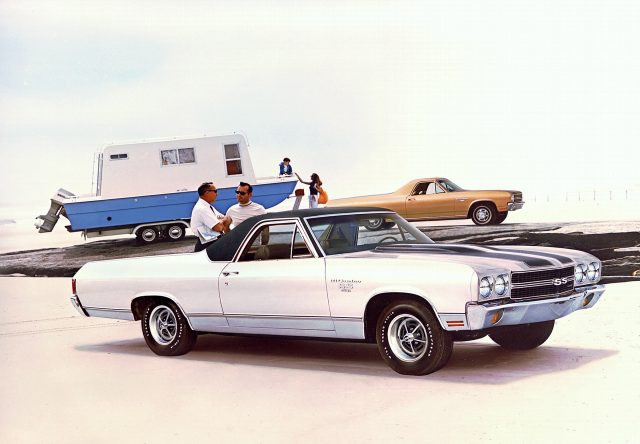America’s ‘ute’ 1970 Chevrolet El Camino SS
America’s ‘ute’. Chevrolet’s classic El Camino is a unique take on the pick-up formula says our man in America, Huw Evans…
Huw Evans Across the pond1970 El Camino SS
Several years ago, my daily driver was a pick-up truck. I ended up selling it as I needed something more practical to cart my then seven-year-old son to and from school (I lived an hour away from his learning centre at the time). I ended up with a small car, albeit a semi-sporting one, complete with a lowered suspension, manual gearbox and tuned exhaust.

Truth be told, I miss having a truck, not so much for its stature but the practicality of having a bed in which to put stuff. Today, trips to Home Depot or Lowes (think stateside version of B&Q or Homebase) just aren’t the same. Purchasing large, bulky items requires thinking ahead, especially when it comes to logistics. There is definitely a truck in my future, that much I can see; the question is, what will it be.
I’m kind of leaning towards something classic – since I don’t plan to use it every day. Older pick-ups, while cool, tend to be somewhat lacking in the refinement department, plus prices seem to be skyrocketing for good ones these days. As a result, my thoughts are turning to something like an El Camino, the popular half car/half truck that Chevrolet offered from the late-1950s through the mid-1980s.
The concept of the half car/half truck really originated down under, in Australia, back in the Thirties, when Ford offered a Coupe Utility variant of the Model A, beginning in 1934. Known as ‘utes’ (short for utility vehicles) these became very popular in Australia, especially once Ford’s archrival Holden (General Motors) joined the fray in 1951. Today ‘utes’ are an ingrained part of Aussie culture with a whole host of automakers offering them at one time or another.
Stateside, while there were some utility offerings as far back as the 1920s, it wasn’t until 1957 when Detroit first offered a factory built half car/half pick-up with the introduction of the Ford Ranchero. GM followed Ford’s lead two years later with the Chevrolet El Camino. The first El Caminos were full-size rigs, based on the Brookwood two-door station wagon and sporting Bel Air level trim. Though sales got off to a decent start (22,246 were produced that first year), a redesigned Ranchero, based on the compact and utilitarian Ford Falcon for 1960, rendered the El Camino a bit extravagant and sales dropped to just over 14,000 units.
While Ranchero production continued interrupted through 1979, GM dropped the El Camino after 1960, choosing to reintroduce it for 1964, based on the mid-size Chevelle. This time however, the product strategy was slightly different. Aimed more at true utility buyers, this generation featured six-cylinder or small-block V8 engine options (283s and 327s with either two- or four-barrel carburettors), and standard air shocks on the rear, coilsprung suspension. Although aimed at the likes of tradesmen and farmers, it didn’t take long for performance to creep back in. By 1966, a big-block engine was available, a 396cu in unit with up to 375 horsepower and offered with a four-speed manual or Powerglide two-speed automatic (the stout TH400 TurboHydramatic three-speed slushbox became available for 1967).
By the late Sixties, the muscle car wars were in full swing, and the El Camino got in on the action, with a Super Sport trim level offered on the redesigned and curvier third-generation model for 1968. Now, not only did the El Camino offer high performance in the shape of the 396cu in V8, but also optional Strato bucket seats, black-out grille, SS emblems and road wheels. This generation proved to be the most popular El Camino yet, selling more than 40,000 units annually, with production totals rising to 48,385 for 1969 and 47,707 for 1970. The latter year arguably represented the pinnacle of El Camino performance and style, with the monster 454cu in big-block V8 available, delivering up to 450 horsepower in LS6 trim.
By 1978 the automotive landscape had changed, with fuel economy and downsizing now the prevailing trends. The El Camino, still based off the midsize A-body (G-body from 1982) but with a unique chassis, returned, along with a GMC derivative named Caballero. This generation would also be the last, ending in 1987 with the demise of GM’s mid-size rear-wheel-drive passenger vehicles.
Today, El Caminos represent a unique vehicle from a unique period in American history. The fifth-generation rigs in particular are still relatively affordable and easy to locate on this side of the Atlantic, plus they have good parts availability which makes them a surprisingly practical choice when looking for a classic American hauler. And, as far as my own automotive aspirations go, I think the idea of adding an El Camino to the Evans fleet definitely has legs!
We’ll just have to see what the budget will stretch to and how much storage space is available! Stay tuned.


